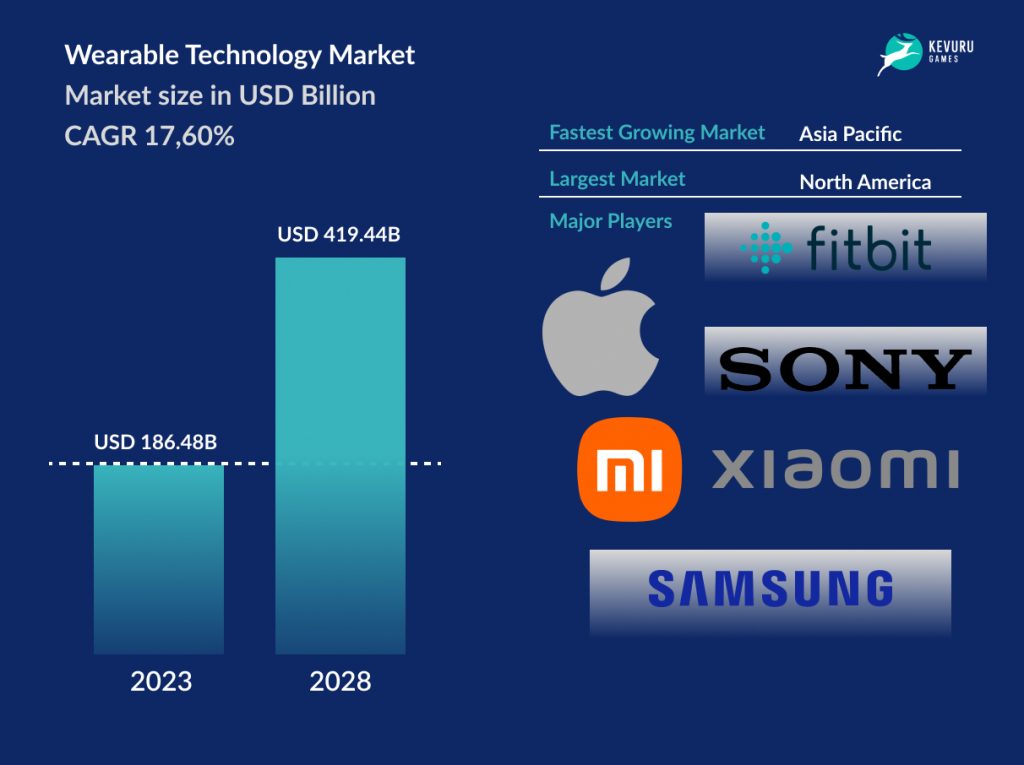Wearable gaming refers to integrating gaming features and experiences into wearable devices, such as smartwatches, augmented reality (AR) glasses, fitness trackers, and virtual reality (VR) headsets. It offers a hands-free and interactive gaming experience where users can seamlessly engage with digital content while fully immersed in their surroundings. Unlike traditional gaming setups that involve controllers or keyboards, wearable gaming brings games directly to the user’s body, allowing for intuitive and natural interactions.
The wearable technology market size is expected to grow from USD 70.30 billion in 2024 to USD 152.82 billion by 2029, at a CAGR of 16.8% during the forecast period, according to the report by MarketsandMarkets. The fastest growing market is the Asia Pacific (India in particular) and the largest market is North America.

What was the first wearable technology?
In the late 1980s and 1990s, there were initial attempts to explore wearable gaming with gadgets like wrist-mounted LCD games. Though primitive, these devices were a glimpse of the future of gaming technology. The evolution of those devices on the market depends on the development of gamification technologies:
- The Advent of VR Gaming: The emergence of virtual reality in the gaming industry introduced the possibility of wearing headsets and interacting with virtual worlds. VR gaming revolutionized how we play, making it more immersive and engaging.
- Fitness Wearables and Gamification: Fitness trackers and smartwatches introduced gaming elements to encourage users to stay active. Gamification features, such as challenges, rewards, and achievements, added an entertaining aspect to fitness routines.
- AR Gaming: Augmented reality gaming made strides with the launch of mobile games like Pokémon GO, which blended virtual creatures with real-world environments through smartphone cameras. AR glasses further extended these experiences, making them more interactive.
- Gesture-Based Gaming: Motion-sensing devices like the Kinect and Nintendo Wii controllers paved the way for gesture-based gaming experiences, removing the need for handheld controllers.

Why is wearable technology so popular?
The popularity of wearable technology can be attributed to its seamless integration into our daily lives, its focus on health and wellness, and the convenience it brings to various aspects of our routines. The ability to personalize, access real-time data, and combine fashion and function all contribute to the widespread adoption of wearables. As technology advances, we can only expect wearable technology to become even more influential, revolutionizing how we interact with the world around us. So, let’s understand why wearable technology is so popular:
1. Convenience at Your Fingertips: Wearable devices like smartwatches and fitness trackers are handy. With information on your wrist, you can check notifications, track fitness goals, and even make payments with a simple tap.
2. Seamless Integration with Daily Life: Wearables fit seamlessly into our routines, making them an effortless extension of our personalities. Unlike traditional devices that feel bulky or intrusive, they blend into our fashion and become a natural part of our daily lives.
3. Enhancing Health and Wellness: Health and wellness have gained much attention recently, and wearable technology significantly contributes to a healthier lifestyle. Fitness trackers monitor activity levels, heart rate, and sleep patterns, allowing users to take control of their wellness.
4. Personalization and Customization: Wearable devices cater to individual preferences and tastes. Whether it’s customizing your watch face to match your mood or setting fitness goals, wearables put personalization in the palm of your hand.
5. Real-Time Data and Insights: Wearable devices provide real-time data and insights about our bodies and surroundings. From tracking steps and calories burned to measuring UV exposure, wearables equip users with valuable information for making informed decisions.
6. Fashion Meets Function: Wearables have come a long way in design, blending fashion with function. Tech companies have collaborated with renowned fashion brands, producing stylish wearables that appeal to a broader audience.
7. Smart Home Integration: Wearables are a convenient remote for smart home devices. From adjusting the thermostat to controlling smart lights, wearables streamline home automation and make daily tasks more manageable.
8. Gaming and Entertainment: The convergence of wearable technology and gaming has opened up new dimensions of fun and entertainment. VR headsets offer immersive gaming experiences, while AR glasses overlay digital content onto the real world, creating interactive and engaging gameplay.
9. Productivity and Efficiency: Wearable technology enhances productivity by providing quick access to notifications, emails, and calendar events without reaching for your smartphone. This streamlined communication saves time and keeps users focused on their tasks.
10. Future-Forward Appeal: Wearable technology embodies the essence of futuristic innovation. As a society, we are drawn to advancements that bring us closer to the tech-savvy worlds portrayed in sci-fi movies, and wearables embody this sense of progress.
11. Social Status and Trends: Wearables have become a status symbol, signifying a person’s tech-savviness and lifestyle choices. Embracing the latest wearable trend has become a way to showcase one’s affinity for cutting-edge technology.
12. Connectivity and Networking: Wearables foster connectivity and networking among users with similar interests. Communities dedicated to fitness, gaming, and tech enthusiasts have flourished, creating a sense of belonging and camaraderie.
Benefits and Challenges of Wearable Gaming
Wearable gaming has undoubtedly brought excitement to the gaming world, but like any technology, it has advantages and challenges. Let’s have a closer look at the benefits and potential hurdles that come with the realm of wearable gaming.
Benefits of Wearable Gaming:
1. Immersive Gameplay Experience: Wearable gaming, especially with virtual reality (VR) headsets, delivers an immersive experience like no other. Players can step into fantastical worlds, feeling as if they are part of the game’s universe, leading to heightened excitement and enjoyment.
2. Intuitive Controls: Wearable gaming often involves intuitive controls like gesture-based interactions or motion tracking. These natural and physical interactions add a new layer of fun and immersion, making gameplay more engaging.
3. Health and Fitness Motivation: Fitness wearables and gaming have joined forces to make staying active enjoyable. Gamified fitness challenges and rewards incentivize players to move, promoting a healthier lifestyle and improved well-being.
4. Diverse Gaming Demographics: Wearable gaming’s appeal transcends traditional gaming demographics. From kids exploring augmented reality (AR) games to older adults enjoying fitness challenges, wearable gaming caters to many players.
5. Social Interaction: Some wearable games embrace social elements, allowing players to team up or compete with friends in the same physical space. It fosters social bonding and adds a dynamic element to the gaming experience.
6. Innovative Use Cases: Wearable gaming has paved the way for innovative use cases, such as combining gaming with education, training, and therapeutic applications. These unconventional uses demonstrate the versatility and potential of wearable technology.
7. Future-Proof Technology: Wearable gaming represents a glimpse into the future of gaming. As technology evolves, wearables will continue to adapt, offering even more seamless and impressive gaming experiences.
Challenges of Wearable Gaming:
1. Cost and Accessibility: High-quality wearable gaming devices can be expensive, limiting accessibility for some gamers. Only some people have access to the necessary hardware, such as a powerful PC for VR gaming.
2. Motion Sickness and Discomfort: VR gaming, in particular, can cause motion sickness and discomfort for some players. Prolonged use of VR headsets may lead to eye strain and fatigue.
3. Battery Life and Charging: Wearable gaming devices require regular charging, and their battery life may not always align with extended gaming sessions, leading to interruptions in gameplay.
4. Content Limitations: The wearable gaming market is still relatively young, which means there may be a limited number of games and experiences available compared to traditional gaming platforms.
5. Privacy and Data Concerns: Wearable devices collect and process user data, raising privacy concerns. Players need assurance that their personal information is secure and used responsibly.
6. Social Isolation: While wearable gaming can enhance social interactions in some cases, it may also lead to isolation as players become engrossed in their virtual worlds.
7. Physical Limitations: Some wearable gaming experiences require physical movement, which may not be suitable for individuals with particular mobility challenges or limited space.
8. Learning Curve: Mastering the controls and interactions in wearable gaming can have a learning curve, especially for newcomers to the technology.

Types of Wearable Games
Wearable gaming has ushered in a new era of interactive and immersive experiences, offering various game types that cater to different preferences and interests, from fitness challenges to AR adventures:
1. Virtual Reality (VR) Games: VR games are at the forefront of wearable gaming, allowing players to enter entirely virtual worlds. With VR headsets, players can explore fantastical landscapes, engage in thrilling combat, and solve puzzles as if they were physically present in the game. A standout example is “Beat Saber,” a rhythm-based VR game where players use lightsabers to slash through flying blocks to the beat of catchy music, providing an energetic and exhilarating gameplay experience.
2. Augmented Reality (AR) Games: AR games blend virtual elements with the real world, creating interactive and dynamic experiences. These games are typically played on smartphones or AR glasses, overlaying digital content onto the player’s physical environment. Players can hunt for virtual creatures in their neighborhoods, solve mysteries in real locations, and even engage in AR-based multiplayer battles. One popular example is “Pokémon GO,” where players use their smartphones to hunt and capture virtual Pokémon creatures that appear in real-world locations, fostering a sense of adventure and exploration.
3. Fitness and Health Games: Fitness and health-focused wearables have transformed exercise into enjoyable gaming experiences. These games motivate players to stay active, offering challenges, rewards, and achievements based on their physical activities. Fitness wearables have turned workouts into exciting adventures, from running challenges to dance-based games. An excellent example is “Zombies, Run!” This app combines fitness tracking with storytelling, motivating users to run and collect supplies in a post-apocalyptic world infested with zombies, turning workouts into thrilling missions.
4. Gamification in Smartwatches: Smartwatches have evolved beyond mere timekeeping devices. They now host a variety of mini-games and gamified apps that users can play on their wrists. From simple puzzles to quick reflex challenges, smartwatches provide bite-sized entertainment for those on the go. For instance, “Tiny Armies” lets users control a tiny army on their smartwatch screen, engaging in quick tactical battles perfect for short bursts of entertainment.
5. Gesture-Based Games: Gesture-based games utilize motion-sensing technology to enable players to control the game using their body movements. These games often involve waving, shaking, or tilting wearable devices to interact with virtual objects, providing a fun and intuitive gaming experience. “Fruit Ninja” is a classic example where players use swiping gestures to slice flying fruits on the screen, testing their reflexes and precision.
6. Multiplayer Wearable Games: Wearable technology fosters social interactions even in gaming. Multiplayer wearable games enable players to team up or compete with friends who also have wearable devices. This social element adds an exciting dimension to the gaming experience, bringing people together in the real world for collaborative or competitive play. “Spaceteam” is a cooperative multiplayer game where players, equipped with their smartphones as wearables, work together as a spaceship crew, following instructions and avoiding impending disasters.
7. Brain-Training Games: Wearable devices have ventured into the realm of cognitive training games. These brain-teasers challenge players’ cognitive abilities, such as memory, attention, and problem-solving, to keep their minds sharp and engaged. “Lumosity” offers a collection of brain teasers designed to improve memory, concentration, and problem-solving skills, providing a fun and educational experience.
8. Story-Driven Adventures: Some wearable games offer immersive story-driven experiences where players become characters in thrilling adventures. Through choices and interactions, players shape the narrative, leading to multiple outcomes and endings.
9. Educational and Learning Games: Wearable technology has found its way into education, providing interactive and immersive learning experiences. Educational games on wearables cover various subjects, making learning engaging and enjoyable for students of all ages. “Duolingo” offers language-learning courses on smartwatches, helping users learn new languages through interactive exercises and challenges.
10. Escape Room Experiences: AR and VR technology have brought escape room experiences to wearables. Players must solve puzzles, uncover clues, and work collaboratively to escape virtual rooms, testing their problem-solving skills and teamwork. “The Room VR: A Dark Matter” offers players a challenging escape room experience in virtual reality, where they must solve puzzles and unravel mysteries to escape haunting environments.

Future of Wearable Gaming
The future of wearable gaming is nothing short of exhilarating, as technological advancements promise to push the boundaries of interactive entertainment even further. With each passing day, wearable technology continues to evolve, offering a glimpse into a world of gaming experiences that were once mere dreams.
Extended Reality (XR), encompassing VR, AR, and Mixed Reality (MR), will be pivotal in advancing wearable gaming. XR will blur the lines between the physical and digital realms, enabling players to experience a seamless blend of virtual and real-world interactions. This heightened immersion will create gaming experiences that feel even more lifelike and captivating.
Brain-Computer Interfaces (BCIs) and Mind-Controlled Gaming will unlock an entirely new dimension of gaming by enabling players to control games with their thoughts and brain signals. Mind-controlled gaming will bring unparalleled interactivity, allowing players to navigate virtual environments and interact with objects solely through mental commands.
Artificial Intelligence (AI) will revolutionize wearable gaming by creating dynamic and responsive gameplay experiences. AI algorithms will adapt games to individual players’ preferences, skill levels, and behaviors, tailoring challenges and narratives for a truly personalized adventure.
Wearable Gaming in Healthcare and Therapy will expand, with applications in physical therapy, rehabilitation, and mental health treatment. Gamified exercises will aid patients in their recovery, providing engaging and enjoyable paths to wellness.
Real-Time Multiplayer gaming devices will enable real-time multiplayer interactions across various devices. Players will seamlessly team up with others, regardless of their chosen platform, providing a unified and inclusive gaming experience.
Summary
Wearable gaming is an exciting fusion of gaming experiences with devices like smartwatches, AR glasses, fitness trackers, and VR headsets. This technology offers a hands-free and immersive gaming adventure, allowing users to interact with digital content seamlessly while remaining fully engaged with their surroundings. Unlike conventional gaming setups with controllers and keyboards, wearable gaming brings the games to your body, enabling natural and intuitive interactions.
Wearable gaming has transformed the gaming landscape, providing immersive, interactive, and personalized experiences. As technology continues to evolve, we can expect even more incredible innovations in wearable gaming, shaping the way we play and interact with games in the future. If you want to be aware of all the new things that appear in the gaming industry, read our trends forecast.










![Indie Game Development: Guide to Revenues, Most Profitable Genres & Monetization [+10 Best Indie Games 2024]](https://kevurugames.com/wp-content/uploads/fly-images/11949/indie-pre-138x138.jpg)